|
Cycle 5 (2015 Deadline)
AGUA-ANDES: Ecological infrastructure strategies for enhancing water sustainability in the semi-arid Andes
PI: Bram Willems (bwillems@cca.org.pe), Centro de Competencias del Agua
U.S. Partner: Andrea Gerlak, University of Arizona
Project Dates: January 2017 - January 2020
Project Overview
Project Webpage
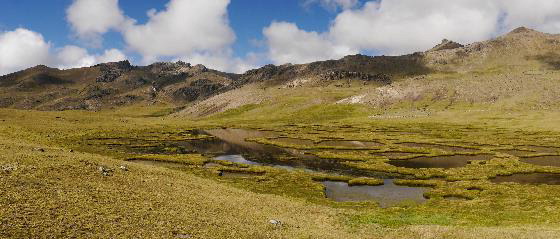 | | Panoramic view of the wetland systems; Photo courtesy of Dr. Willems |
This project focuses on Ecological Infrastructure as an adaptation strategy for ensuring water sustainability in South America’s Semi-Andes region. Dr. Willems and his team seek to advance our understanding of ecohydrologic processes that take place in headwaters ecosystems, effects of changes in climate and anthropogenic drivers, and how these are reflected in the water supply along the basin. Andean puna wetlands are far less studied than tropical glaciers, but they play an even more crucial role in the hydrology of the majority of Peru’s Andean basins and hence in the provision of water to urban and productive centers of the country. As glaciers have almost disappeared in the team’s study site, this project will produce relevant information for climate change adaptation plans by generating new knowledge about post-glacier hydrological processes in the Andes.
In addition, the researchers will study the eco-hydrological properties of human-made water-regulating ecosystems and their scalability for ecological interventions in urban and rural areas.
On the social science side, the team aims to better understand how actors make decisions around Ecological Infrastructure. Specifically, they want to know how decision-makers receive information and learn about ecological infrastructure design and implementation, as well as what obstacles they face in understanding and advancing ecological infrastructure. This entails understanding trade-offs decision-makers face with regard to strategic planning, public investments, and institutional capability.
Overall, the objective of this project is to establish an integrated, participatory approach to the design and implementation of Ecological Infrastructure Strategies that can be utilized in Peru’s Andean urban centers and communities. This research will address a key challenge in understanding how society undergoes changes in the use and distribution of environmental resources, and it should contribute to our understanding of decision-making around water sustainability more broadly.
The project is aligned with USAID’s new Adaptation Flagship Program for Peru, in which green infrastructure investments in watersheds are a key adaptation strategy. The project site (the headwaters of the Cachi basin and the 180,000-inhabitant city of Huamanga in Ayacucho) was selected to align with USAID’s focal regions within Peru. To promote interdisciplinary research and develop effective ways of mobilizing science to address societal needs, Dr. Willems and his team plan several specific activities.
They will develop robust scenarios pertaining to the water supply in the region under different global change pathways. These scenarios will be implemented together with the Regional Government of Ayacucho, local governments, and the local water authority, institutions responsible for elaborating the policy, strategy, local planning, and regulation of water resources.
The researchers will also develop Ecological Infrastructure Strategies by integrating natural and man-made water-regulating ecosystems with landscape planning, urban planning, and water and wastewater management, giving due and balanced consideration to social, economic, and environmental factors and involving local authorities and community organizations. These Ecological Infrastructure Strategies will facilitate the incorporation of ecological infrastructure within water planning investments. Throughout the project, they will work closely with the University of Ayacucho (UNSCH) on the implementation of the Regional Research Institute for Water – Food – Energy Security (ir-NEXUS), which is envisioned as a think-tank that supports policy formulation and public investment processes with relevance to the local and the Andean region sustainable development.
Finally, they will support the implementation of postgraduate programs at UNSCH to actively involve graduate students in the natural and social sciences.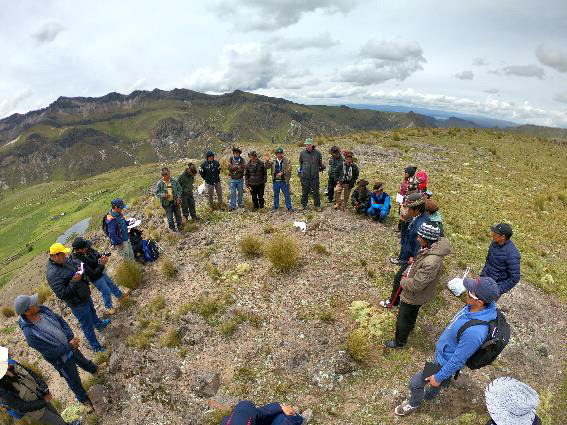 | 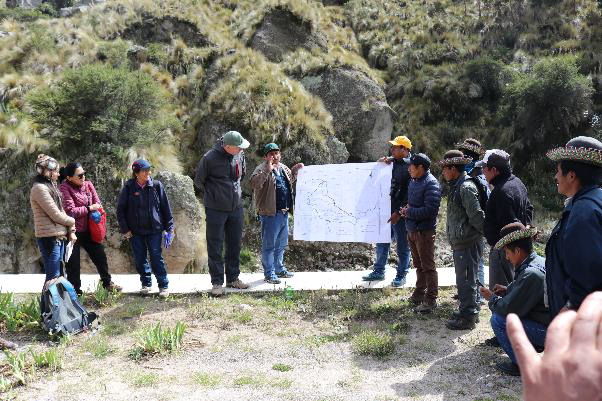 | | Presentation of the PEER project to the authorities of the Peasant Community of Chuschi, SUNASS and the Regional Government of Ayacucho [Photo courtesy of Dr. Willems] |
Final Summary of Project Activities
- The team has gained substantial understanding of the eco-hydrological behavior of Andean puna wetlands and their role in the water provision along the basins. The PEER team's studies have shed light on the feedback interrelations between anthropogenic processes and the wellbeing of Andean ecosystems and water resources. At the city level, the team have advanced the understanding surrounding the complexity of urbanization processes and designed interventions based on functional ecological infrastructure interventions for both solving water related problems (e.g. landslides, water shortage) and improving the wellbeing of the neighborhoods. The knowledge built is crucial for the design of preservation and adaptation strategies towards global change, both at the basin and city level.
- Technical achievements include: validation of remote sensing techniques for identification of Andean wetlands, characterization of soil cover, and the construction of ecosystem pressure maps. Furthermore, water treatment technologies for drinking water and wastewater treatment have been developed and validated in real conditions. On the basis of these experiences, the team is now capable of designing and implementing solutions for rural drinking water and sanitation.
- The project produced 3 journal articles, 3 proceedings, 1 book chapter, 4 MSc theses, 3 undergraduate theses, 6 international theses (1 UWE, 5 KUL), 2 broad audience publications, and leveraged $843,550 in funding.
The basis for the design of ecological infrastructure strategies at the city level - Redefining the Urban Andes, - is available here.
Capacity Building:- In collaboration with the Urban-Andes projects, the PEER project contributed substantially to the organization of two International Design Workshops, in which more than 70 professionals coming from Ayacucho, Peru and abroad (Belgium, US, South Africa, Australia, Slovakia and Brasil) actively participated. Each workshop event consisted of a 10-day intensive training session in landscape and urban design techniques, during which designs of ecological infrastructure strategies were developed.
- A total of 16 scholarships were granted to outstanding local students, who developed their research work within the framework of the PEER project and complementary projects (Newton and Urban-Andes). The PEER project sponsored participation of the Ayacucho team in several capacity building sessions in Lima and abroad. For instance, in 2018 and 2019, the Ayacucho team has had the opportunity to attend the master classes organized within the IV Panamerican Wetland Congress and the Expo Agua Perú 2019, respectively, both in Lima. Following completion of the PEER project, the team continues research on water treatment technologies at the partner university, UNSCH. Currently, 2 students, under the lead of Prof. Cipriano Mendoza, are working on the development of new pilots as part of their thesis research, beyond PEER.
Examples of data/research used or research used to inform a policy or program:
- PEER team's research experience in Andean headwaters areas served for the design of the guidelines for the assessment of Andean ecosystems within the framework of the Payment for Ecosystem Services Law (MERESE Law). These guidelines were developed under request of the Ministry of Environment and will become the official document of the Ministry of Environment, that will guide the implementation of MERESE along the country.
- The results of the project's research activities in the highlands of the Chicllarazu sub-basin were presented in a technical report to the peasant community of Chuschi, following the template that is used for the formulation of green public investment projects. Thus, the report itself constitutes a first step in the process towards implementing ecosystem restoration and/or preservation interventions in the headwaters of the Cachi basin, a process that also involves the participation of SUNASS, SEDA Ayacucho, and the Regional Government of Ayacucho.
The team continues collaborating with SUNASS in providing them with data on water flow in two of their monitoring sites in the Cachi basin. Through the project, the team have acquired water level sensors, which have been installed at the SUNASS monitoring spots.
Project Impact Highlights:
- Constructed a strong collaboration network composed of the Ministry of Environment, the Regional Government of Ayacucho, the Municipality of Huamanga, the water utility SEDA Ayacucho, SUNASS, the peasant communities of Chuschi and Pilpichaka, international NGO’s (CONDESAN, Forest Trends), private companies (e.g. Buenaventura Mining Company).
- Worked closely with the peasant communities of Pilpichac (Huancavelica) and Chuschi (Ayacucho), providing these the technical and scientific assistance for the design of public investment projects within the framework of the Payment for Ecosystem Services Law (MERESE Law), oriented to preserve water resources and grassland in the headwater areas.
- Commissioned by the Ministry of Environment, we have developed the guidelines for the assessment of Andean ecosystems within the framework of the MERESE Law.
- Within the Agua-Andes congress of September 2017, together with the national council for science and technology of Peru (CONCYTEC), the team organized a workshop for the presentation of the National Research Plan for Water Resources. During the workshop, the team of CONCYTEC have had the opportunity to receive feedback from stakeholders, decision makers and researchers, and hence include the local agenda into this major policy tool. It is worth mentioning the plan, once approved, will trigger several funding mechanisms for developing research relevant to water resources management. So, our PEER has provided a platform for further enriching a key policy tool of the Government of Peru.
- The CCA has been invited by the Ministry of Environment to serve on two Commissions: (1) the Technical Commission on Andean Ecosystems and (2) the Technical Commission on Andean Peatlands. Both commissions are further integrated by representatives from the Ministry of Environment, the Ministry of Agriculture, SUNASS, universities and international NGO’s, among others.
- In collaboration SUNASS Ayacucho and the Centro Loyola, the PEER team has designed and installed a water filtering systems in two schools of Ayacucho; namely, Javier Heraud of Carmen Alto (211 students) and Abraham Valdelomar (1206 students), benefiting more than 1400 students. Additionally, the CCA team members designed a proposal for a Water Interpretation Center on request of the peasant community of Cuchoquezera. The objective of this center is to raise awareness on resilient waterrelated practices. Aslo, a pilot wetland system for treating wastewater to be recycled for irrigation of green areas in Ayacucho city has been developed with the Municipality of Huamanga, CEDAP and SUNASS. Team members also collaborated with ARPOA to conduct workshops on urban and organic agriculture.
- The PEER project largely contributed to the organization of the Agua-Andes International Congress (2017) and the I Sustainable Cities and Communities Expo (2019) in Ayacucho. Both events counted on a total of more than 20 international speakers and an attendance above 600 participants. During these events, the advances and results of the PEER project have been presented by the team members. Furthermore, the PEER project also collaborated with the organization of the IV IV Panamerican Wetland Congress in Lima (2018).
- As part of the PEER project, the project team have started a research area on water treatment technologies in the UNSCH, their partner university. Currently, 2 students, under the lead of Prof. Cipriano Mendoza, are working on the development of new pilots as part of their thesis research, beyond PEER..
- One of the ongoing impacts of the PEER project continues to be Expo Agua Peru, an initiative promoted by the CCA and the country’s main water expo, where the latest technological innovations and integral solutions for the integrated management of water resources are presented. Due to COVID pandemic, With 5 editions organized since 2015, Expo Agua Peru has been consolidated as the main gateway to the emerging water market in Peru. For 2020 and 2021, the US is the host country. According to Dr. Willems, the PEER project has allowed CCA to start a collaboration with the Commercial Service of the US Embassy in Lima back in 2017, and participation of the US as host country is the result of this process (see U.S. Embassy video ). The event brings together leading companies in their fields, international experts, decision makers and governmental bodies, and a broad segment of end-users coming from the water sector and related sectors (agriculture, mining and industry); who share their experiences and solutions to the problems and challenges that face Peru and the Andean region.
- Rossi Taboada and Martín Leyva who initially got involved as students during the first Willems' PEER project back in 2013, became key team members of the CCA, first leading work packages, then taking charge of the full management of projects to, finally, writing proposals and securing new funding for CCA, with Dr. WIllems role as an advisor.
Peer-reviewed Publications, Proceedings, and other research outputs
Grande, J.A., Loayza-Muro, R., Alonso-Chaves, F.M., Fortes, J.C., Willems, B., Sarmiento, A.M., Santisteban, M., Dávila, J.M., de la Torre, M.L., Duraes, N., Diaz-Curiel, J., and Luís, A.T., 2019. The Negro River (Ancash- Peru): A unique case of water pollution, three environmental scenarios and an unresolved issue. Science of the Total Environment 648, 398-407.
Dr. Willems team contributed a chapter to a study that will be published under the auspices of UNESCO-IHP regarding communal organizations for water management, for which they presented the Peruvian context. The study is expected to be published before the end of 2020.
The PEER team prepared a publication entitled Redefining the Urban Andes, that served as the basis for the design of the three cases tackled during the 2nd International Design Workshop. PEER work attracted the attention of the press as well - an article was published in La Republica. Most recently, an article on Dr Willems and his work was published by Peru 21. 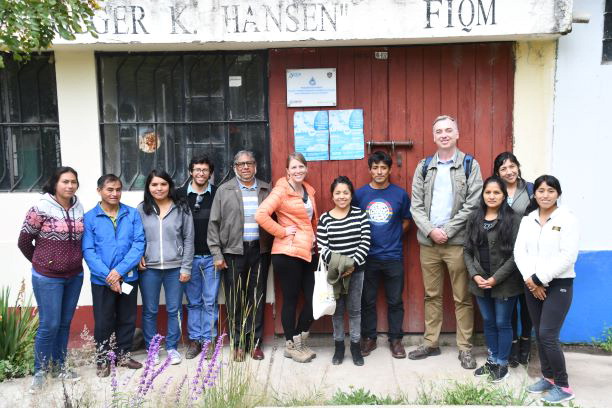 | 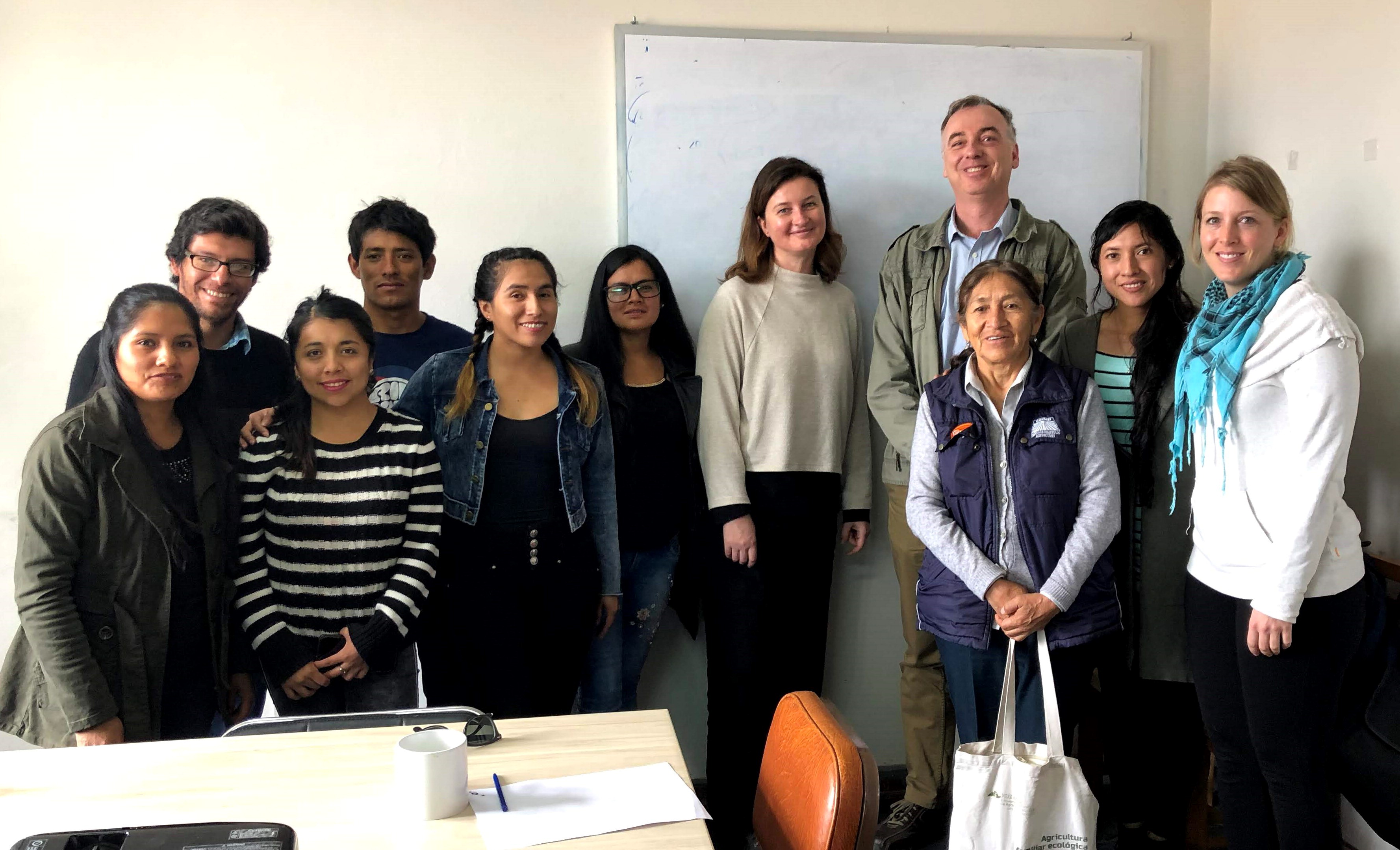 | | | NAS and USAID site visit in Ayacucho with Bram Willems and his student team. January 2020 |
|
|
|
|








